 Quantum-
Quantum-
Integrated
Discovery
Orchestrator

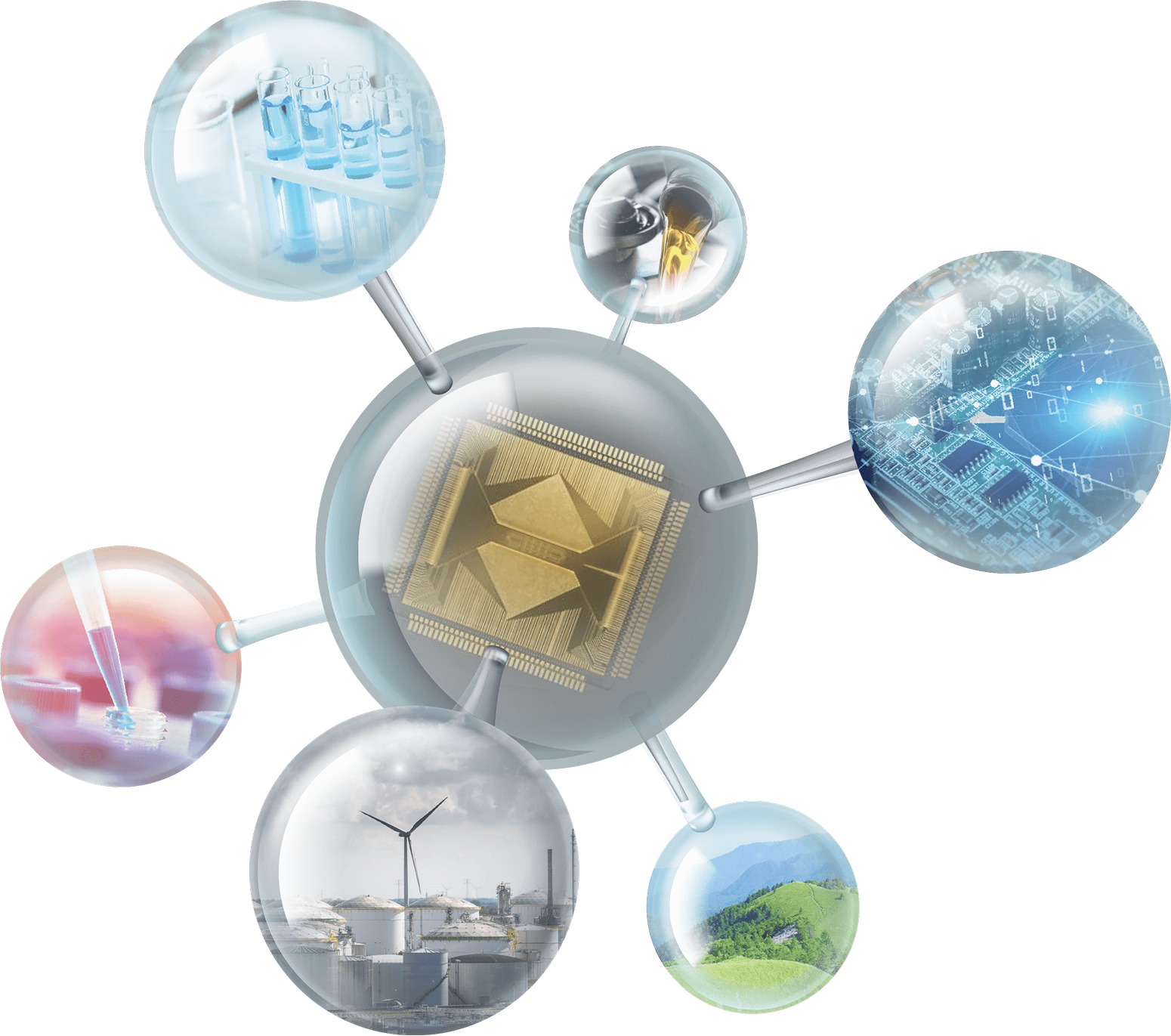
Pioneering the Future of
Computational Chemistry Today
Achieve unparalleled
results with
state-of-the-art computational
chemistry technology
and easily explore advanced
quantum computing environments.

What’s NewNews
ConceptFour Key Advantages of QIDO
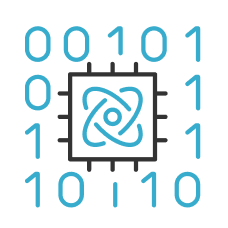
Hybrid use of classical and quantum computing
Hybrid use of classical and quantum computing
This platform provides practical computational chemistry functions using classical computing while preparing for the quantum computing era. It utilizes computational chemistry results obtained via classical computing and applies more advanced methods (post-Hartree–Fock methods) or quantum computing to the most important molecular orbitals for accurately describing the electronic structure.
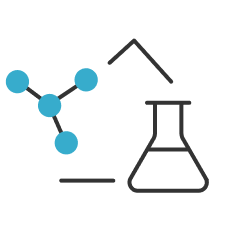
Accurate reaction analysis
Accurate reaction analysis
Reaction analysis based on density functional theory can be efficiently executed via cloud computing, enabling the identification of reaction pathways and transition states. Additionally, post-Hartree–Fock methods can be used to conduct accurate energy calculations. Users can select the optimal balance between computational cost and accuracy.

Preparing for the Quantum era
Preparing for the Quantum era
By leveraging practical computational chemistry functions through classical computing, this platform sets the stage for the quantum computing era. The SaaS also enables efficient R&D using quantum computing, based on the computational chemistry results obtained via classical computing.

Market-driven approach
Market-driven approach
This platform develops solutions based on real-world needs in computational R&D. Leveraging its deep expertise, it ensures practical functionality and delivers top performance on current computational resources. It emphasizes practical applications in areas such as pharma, mobility, energy, semiconductors, and materials, where quantum-enhanced simulations could contribute to improved efficiency and innovation.
FeaturesMain Features of QIDO
Automatic identification of transition states
Automatic identification of transition states
Automatically identify transition states and reaction pathways by specifying reactants and products.
Accurate energy calculations using post-Hartree–Fock methods
Accurate energy calculations using post-Hartree–Fock methods
Construct appropriate active spaces using the atomic valence active space (AVAS) approach and efficiently perform accurate energy calculations using the complete active space method.
Flexible use of computational resources
Flexible use of computational resources
Users can select the size of the active space and the calculation method, adjusting the desired accuracy and computational cost.
Output of energy calculation results
Output of energy calculation results
Display energy values for reactants, products, and transition states.
Access to advanced quantum computing environments
Access to advanced quantum computing environments
Seamless integration with InQuanto - Quantinuum’s state-of-the-art chemistry platform – and their cloud platform, Quantinuum Nexus, allows access to cutting-edge quantum computing technology and hardware.
InsightsWhat Our Users Say
Toray Industries, Inc.
Masahiro Kitabata, Ph.D., Research Fellow, Advanced Materials Research Laboratories
(Feedback received during the beta testing phase)
Through the beta testing, we found that QIDO has strong potential to become a transformative platform for accelerating materials development using quantum chemical calculations.Particularly impressive was the intuitive UI. Reaction path searches are automatically executed simply by uploading chemical structures. As a result, it can be easily used even by experimental researchers. Transition state and pathway information crucial for synthesis research can be quickly obtained. This allows theoretical understanding to be incorporated more easily into daily operations in the field. At the same time, computational chemists can achieve more efficient analysis and verification.
In addition, integration with InQuanto and Quantinuum Nexus enables seamless combination of classical and quantum computing. This makes QIDO a unique product that shows promise for preliminary verification towards the practical application of future quantum computers. QIDO is expected to serve as a bridge connecting experimental and computational researchers, as well as classical and quantum computing. In doing so, it may be a powerful platform for driving forward the acceleration of materials development.
JSR Corporation
Yu-ya Ohnishi, Ph.D., Research Fellow, Deputy General Manager, Materials Informatics Initiative, RD technology and digital transformation center
(Feedback received during the beta testing phase)
Quantum chemistry calculations using conventional computers have become indispensable in various fields of materials design thanks to improvements in computing power and advances in computational methodologies. However, many tasks, such as creating input, handling errors, and extracting information from output, require specialized knowledge and have been considered the domain of computational chemistry experts. The platform provided by QSimulate lowers the barriers to computation by simplifying input, automating error handling, and focusing output on necessary information, making it an integral tool in the daily workflows of synthetic organic chemists at JSR. By providing access to quantum chemical simulations on quantum computers via InQuanto, this platform is expected to deepen insights into phenomena that could not be accurately calculated on conventional computers, thereby streamlining materials development. Seamlessly bridging the present with the era of practical quantum computing, this new platform could position users to benefit from quantum advantage ahead of the curve.
Panasonic Holdings Corporation
Takahiro Ohgoe, Ph.D., Senior lead researcher, Green Innovation Center, Green Transformation Division
(Feedback received during the beta testing phase)
This platform provides users with a tool to perform chemical reaction simulations through a graphical user interface. One of its key features is the support for constructing active spaces based on the AVAS approach, which is essential for accurate molecular calculations, . Another notable aspect of the platform is its integration with InQuanto, a quantum algorithm-based software platform, which reflects its readiness for future quantum computing applications. In the anticipated era of large-scale fault-tolerant quantum computing, materials simulation is regarded as a promising application domain. Integrated with quantum computing, this platform is expected to offer opportunities for early-stage validation in preparation for future breakthroughs.
Chugai Pharmaceutical
Akihiko Arakawa, Ph.D., Data Science Group, Digital Solution Dept., Digital Transformation Unit
(Feedback received during the beta testing phase)
This application offers an intuitive interface that combines user-friendly operability with clear, instantly interpretable result visualization—making reaction pathway exploration easier and more efficient than ever. In addition, its integration with InQuanto offers the potential to perform reaction pathway analyses at high levels of computational accuracy, which have traditionally been difficult to achieve. At present, we recognize that there remain several technical challenges in applying the system to complex molecular calculations encountered in drug discovery and pharmaceutical research. Likewise, quantum computing itself is at a stage where further technological advancement and validation of practical usability are actively progressing. These challenges are not unique to this application, but rather reflect broader technical hurdles across the field of computational chemistry. As these challenges are steadily addressed, we expect this application to play a meaningful role in accelerating and optimizing the synthesis and process development of candidate molecules with complex chemical structures—ultimately contributing to innovation in drug discovery and the advancement of pharmaceutical development.
DemoA Quick Guide to Reaction Discovery with QIDO
This video provides a quick overview of how QIDO uses state-of-the-art computational chemistry technology and quantum simulations to accelerate reaction discovery.
Learn More
About QIDO
Discover More About Features
and Implementation Benefits
Inquire About Implementation
or Consult Us
Core TechnologiesProprietary Technologies That Drive QIDO
Transition-state search technology
The reaction analysis workflow orchestrates a complex series of simulations to locate transition states and accurately predict reaction barriers.
The workflow steps are performed with increasingly sophisticated quantum chemistry methods to allow for extensive screening of candidate reaction paths before a high-accuracy optimization and QIRC calculation results in precise energy predictions along the reaction path.
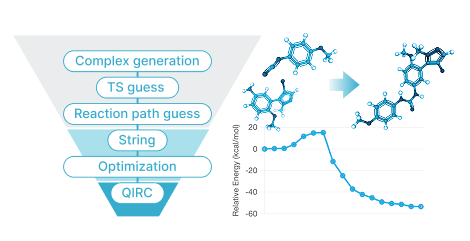
Active space approach
The atomic valence active space (AVAS) approach, combined with projection-based embedding, allows for the selection of an optimal set of active space orbitals for energy refinement with quantum algorithms.
The active space approach implements Hartree-Fock embedding in DFT along the reaction path to construct a consistent active space that can be used for quantum simulations on current quantum devices.
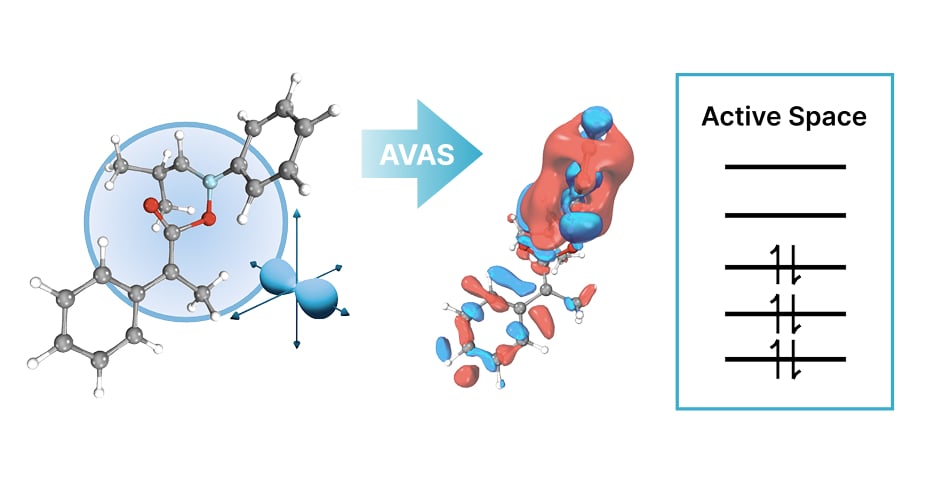
Quantinuum's quantum hardware development
Quantinuum is leading the charge toward large-scale, fully fault-tolerant quantum computing. With unparalleled fidelity, reconfigurable all-to-all connectivity, mid-circuit measurement, and qubit reuse, Quantinuum’s Systems offer an unmatched advantage for pushing the field of quantum computing forward.
Quantinuum’s QCCD technology leads the race with the highest fidelity and quantum volume in the market. Its reconfigurable all-to-all connectivity means that Quantinuum will always be able to deploy the latest advances in Quantum Error Correction (QEC) or Algorithmic Design.
Quantinuum has a proven approach, being the only company to deliver a real commercial application (Certified Randomness). Quantinuum also leads the field in fault-tolerance, being the only company to deliver the full-error corrected gate set required for Fault-Tolerance. Quantinuum Systems’s computers are the top choice for leading industrial firms and academics alike.
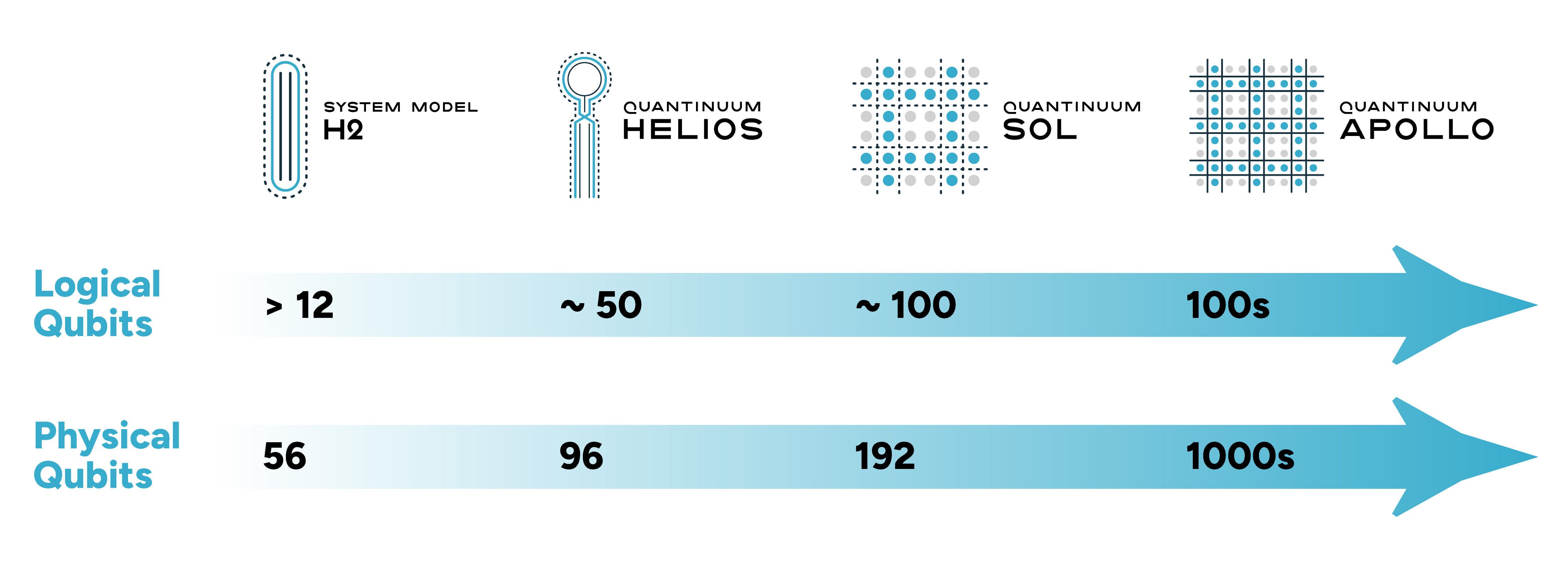
InQuanto
InQuanto is Quantinuum’s state-of-the-art platform designed to accelerate hybrid quantum computational chemistry research for both industrial and academic users. Leveraging Quantinuum’s full-stack and a range of advanced quantum hardware, InQuanto empowers researchers to push the boundaries of quantum computing.
- Customizable and extensible workflows for beginners to expert users
- Up to 10x more accurate and resource efficient than leading open-source competitors
- Over 45 cutting-edge algorithms and methods, including both variational and phase estimation algorithms
- Proprietary error reduction techniques to reduce resources and enable logical qubits
- Get started quickly with detailed documentation, tutorials, practical examples and support from our expert team
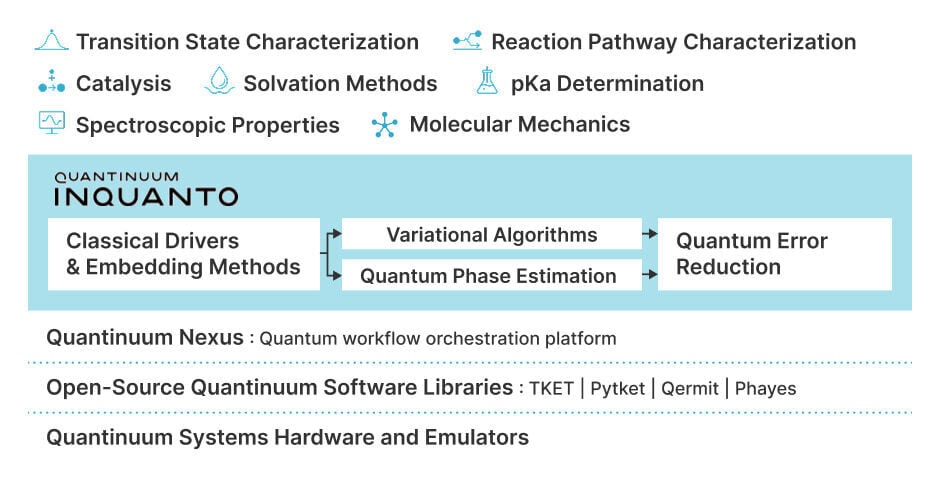
RoadmapDevelopment Roadmap
Long-term vision and ongoing improvement
Mitsui promotes this collaboration with a long-term perspective, aligned with the practical roadmap of quantum technologies.
In addition to providing the best possible solutions for current customer needs, Mitsui actively explores both short- and long-term use cases and business opportunities with future collaboration in mind.
Technological innovation and adaptability
Quantinuum offers the world’s most powerful quantum computers, Quantinuum Systems, along with their state-of-the-art quantum chemistry software, InQuanto™, to accelerate quantum computational chemistry research. QSimulate flexibly adapts to these technological advancements, quickly integrating them to offer services that consistently incorporate the latest technology.
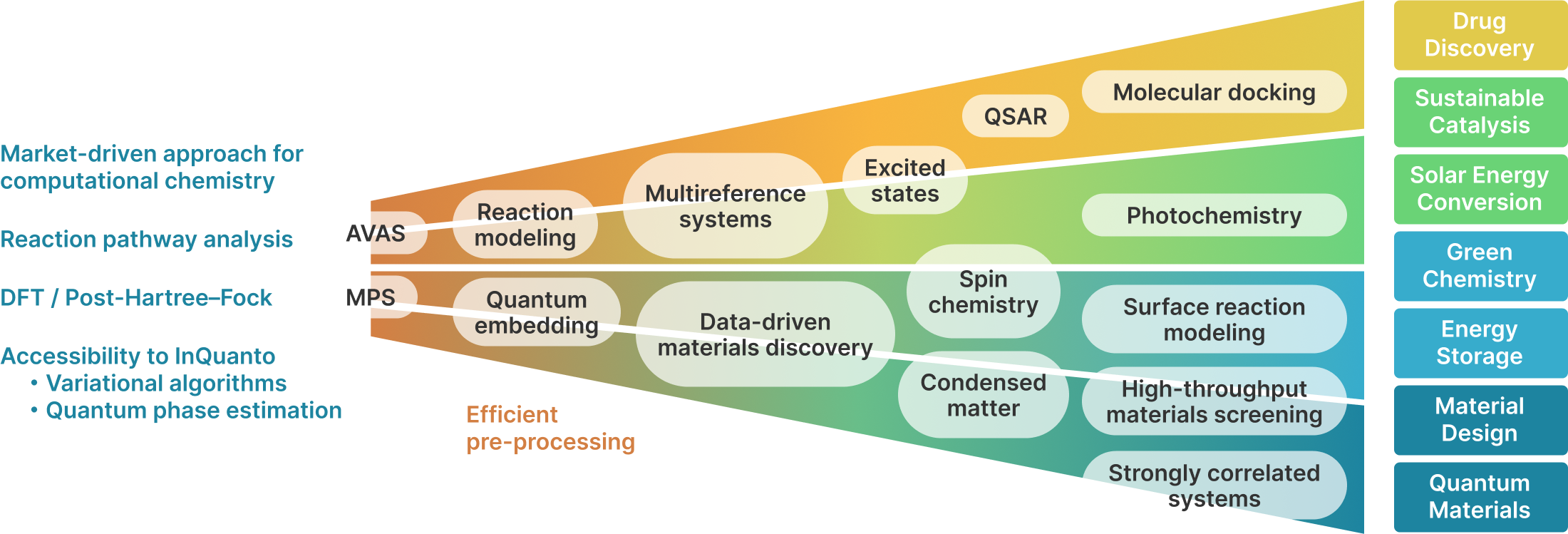
VisionWhat Could Quantum Computing Bring to the Pharmaceutical,
Chemical, and Energy Industries?

Innovative drug discovery
In the drug discovery process, it is essential to thoroughly analyze the interactions between candidate drug molecules and target proteins. It is anticipated that quantum computers will be capable of simulating the electronic structure and molecular interactions with high precision, enhancing the accuracy of predictions regarding drug efficacy and potential side effects. Furthermore, they will be able to efficiently analyze strongly correlated electron systems, such as enzyme active sites, which are challenging for conventional computers. This capability could significantly aid in the design of new drugs and the enhancement of existing ones.

Design of high-efficiency catalysts and enzymes
Quantum computers are expected to excel at modeling strongly correlated electron systems found in many catalysts and enzymes containing transition metals. This capability is anticipated to facilitate the design of new catalysts and enzymes with high activity and selectivity. Efficient design of catalysts and enzymes through quantum computing may drive significant advancements in industries such as energy production, environmental protection, chemical manufacturing, biocatalysis, and drug discovery.

Energy conversion
and sustainability
Quantum computing offers significant potential for enhancing the efficiency and sustainability of energy conversion technologies. For instance, it is expected to drive the development of energy-efficient and environmentally friendly materials, as well as improve technologies for efficient carbon dioxide capture and reuse. Additionally, quantum computing may advance the production of green ammonia and green hydrogen, along with carbon capture technologies.

Battery efficiency and energy storage
Quantum computing is anticipated to drive the development of batteries with enhanced energy density and performance. By gaining a deep understanding of molecular interactions within batteries, quantum computing could facilitate the creation of efficient, durable, and safe energy storage solutions. This advancement can lead to the production of batteries that are ideal for electric vehicles and grid energy storage.
Learn More
About QIDO
Discover More About Features
and Implementation Benefits
Inquire About Implementation
or Consult Us
PartnersStrategic Partners

Headquartered in Boston, MA, QSimulate is a leader in quantum simulation technology for material design, drug discovery and other industry research and development.
The company offers a range of products and services designed to leverage the power of quantum mechanics to solve industrial-scale problems like never before.
To learn more, visit https://qsimulate.com, or contact QSimulate at info@qsimulate.com

Quantinuum is the world leader in quantum computing. The company’s quantum systems deliver the highest performance across all industry benchmarks. Quantinuum’s over 550 employees, including 370+ scientists and engineers, across the US, UK, Germany, and Japan, are driving the quantum computing revolution. For more information, visit https://www.quantinuum.com